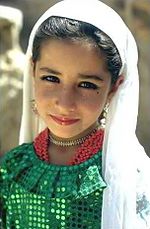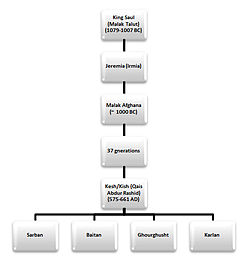- Afghana
-

Part of a series on
PashtunsKingdoms (Lodi · Suri
Hotaki · Durrani)
Afghanistan · Pakistan
Pashtunistan · Pakhtunkhwa
Pashtunization
Afghana or Avagana[1] (born ~ 1000 BC) is considered in Afghan folklore[2] a tribal chief or prince of Bani Israel (Israelite) origin and a progenitor of modern-day Pashtuns (ethnic Afghans)[3][4][5][6][7], the largest ethnic group in Afghanistan and second largest in Pakistan. The ethnonym "Afghan" is believed to derive from his name.[3][4][5][6][7]
Contents
House of King Saul
According to the Tanakh, King Saul (Talut) was the son of Kish, of the family of the Matrites, and a member of the tribe of Benjamin, one of the twelve Tribes of Israel.(1 Samuel 9:1-2 Saul married Ahinoam, daughter of Ahimaaz and had four sons and two daughters. The sons were Jonathan, Abinadab, Malchishua and Ish-bosheth. Their daughters were named Merab and Michal.[8]
Afghan folklore and some Muslim writers suggest that King Saul had five sons instead of four, the fifth was named Irmia (Jeremia).[9][10][11]
Afghana
The legend describes Afghana as the grandson of King Saul (Talut).[9][10][11] Afghana was the son of Irmia (Jeremia), and Jeremia in turn was the son of King Talut. This name is mentioned in the form of Abgan in the 3rd century CE by the Sassanians[12] and as Avagana in the 6th century CE by Indian astronomer Varahamihira.[1]
It is mentioned that Afghana was orphaned at a young age, and brought up by King David. When Solomon became the king, Afghana was made commander-in-chief of the army. Afghana is also credited with the building of the first temple (also known as Bait ul-Mukaddas or the Temple of Jerusalem):[13][14][15]
According to Tadhkirat al-Muluk, Afghana migrated to the place known as Takht-i-Sulaiman and generations later Qais Abdur Rashid a descendant of Afghana embraced Islam.[16][17]
Qais Abdur Rashid
Qais Abdur Rashid (575 - 661), also known as Kesh, Qesh and Imraul Qais, is another legendary ancestor of the ethnic Afghans (Pashtuns). He is the first Afghan who travelled to Mecca and Medina in Saudi Arabia during the days of Muhammad.[18] Qais Abdur Rashid's pedigree ascended in a series of thirty-seven degrees to King Talut (Saul) through Afghana.[19][20][21][22][23][24][25][26][27][28]
Death
According to legend, after his death he was buried in what is now Ghor, Afghanistan.[citation needed] In other folklore however, Qais Abdur Rashid in his old age, when he felt his time was near, asked his sons to bury him in the vicinity of Zhob (Sulaiman Mountains) at the location where his ancestor Afghana was buried.[29][30]
See also
- Nimat Allah al-Harawi author of Tarikh-i-Khan Jahani Makhzan-i-Afghani also known as The History of the Afghans
- Ten Lost Tribes
References
- ^ a b Ch. M. Kieffer (December 15, 1983). "Afghan". Encyclopædia Iranica (Encyclopædia Iranica Online ed.). Columbia University. http://www.iranica.com/articles/afgan-in-current-political-usage-any-citizen-of-afghanistan-whatever-his-ethnic-tribal-or-religious-affiliation.
- ^ Kharnam, R (2005). Encyclopaedic ethnography of Middle-East and Central Asia. Global Vision. p. 20. ISBN 978-8182200623. http://books.google.co.uk/books?id=q_189OeDwSMC&pg=PA20&dq=%2Bafghana+saul&hl=en&ei=0IEATq60N8ei8QPV2In8Dg&sa=X&oi=book_result&ct=result&resnum=4&ved=0CD4Q6AEwAzgK#v=onepage&q=%2Bafghana%20saul&f=false.
- ^ a b Socio-economic Behaviour of Pukhtun Tribe By Dipali Saha, Dipali Saha - 2006 - 282 pages - Page 124.
- ^ a b India and the Afghans: a study of a neglected region, 1370-1576 A.D., Amrendra Kumar Thakur, Janaki Prakashan, 1992 - 231 pages, Covers the history of Bihar during the Afghan rule in India. Page 2 & 9.
- ^ a b Journal of the Research Society of Pakistan, Volume 22, Research Society of Pakistan, 1985 - Page 4.
- ^ a b Pukhtun economy and society: traditional structure and economic development in a tribal society, Akbar S. Ahmed, Routledge & Kegan Paul, 1980 - 406 pages - Page 128 & 129.
- ^ a b Niamatullah's history of the Afghans , Volume 1, Niʻmat Allāh, Nirod Bhusan Roy, Santiniketan Press, 1958 - Page 5 & 9.
- ^ 1 Samuel 14:51 lists three sons - Jonathan, and Ishvi, and Malchi-shua - and the two daughters. But see also 2 Samuel 2:8 and 1 Chronicles 8:33.
- ^ a b A grammar of the Pukhto, Pushto, or Language of the Afgháns, By Henry George Raverty - - 1860 - 204 pages - page 6.
- ^ a b Volume 13 of Encyclopaedia of Religion and Ethics - Editors: James Hastings, John Alexander Selbie, Louis Herbert Gray - Publisher C. Scribner's sons - Original from the University of Michigan.
- ^ a b The rise of the Indo-Afghan empire, c.1710-1780 By Jos J. L. Gommans - 1995 - 219 pages - Page 164.
- ^ "History of Afghanistan". Encyclopædia Britannica Online. http://www.britannica.com/EBchecked/topic/7798/Afghanistan/129450/History?anchor=ref261360. Retrieved November 22, 2010.
- ^ Pathan tribal patterns: an interim study of authoritarian family process and structure, Ruth Einsidler Newman, Foreign Studies Institute, 1965 - 111 pages.
- ^ Among the wild tribes of the Afghan frontier, Theodore Leighton Pennell, Oxford University Press, 1975 - 323 pages - page 31.
- ^ Encyclopedia of Religion and Ethics. Edited by James Hastings, Volume 1, James Hastings, John Alexander Selbie - 2001 - 343 pages - Page 159.
- ^ Journal of the Pakistan Historical Society , Volume 39, Pakistan Historical Society, Pakistan Historical Society, 1991.
- ^ Tadhkirat al-Muluk: A Manual of Safavid Administration, Translated by V. Minorsky, Publisher: Gibb Memorial Trust; 2nd edition (December 1, 1980) Language: English, ISBN 978-0906094129, Paperback: 360 pages.
- ^ Meaning and Practice, Afghanistan Country Study: Religion, Illinois Institute of Technology (retrieved 18 January 2007).
- ^ Niamatullah's history of the Afghans , Volume 1, Niʻmat Allāh, Nirod Bhusan Roy, Santiniketan Press, 1958.
- ^ Census of India, 1901 , Volume 18, Part 1, India. Census Commissioner, Edward Albert Gait, Office of the Superintendent of Government Printing, India, 1902 - Page 88.
- ^ Settling the frontier: land, law and society in the Peshawar valley, 1500-1900, Robert Nichols, Robert Nichols (PhD.), Oxford University Press, 2001 - 321 pages.
- ^ The people of India, Sir Herbert Hope Risley, William Crooke, Oriental Books Reprint Corp.; exclusively distributed by Munshiram Manoharlal, 1969 - 472 pages - Page 64.
- ^ Balochistan: land, history, people, Ihsan H. Nadiem, Sang-e-Meel Publications, 2007 - Balochistān (Pakistan) - 160 pages - Page 16.
- ^ Pakistan pictorial, Pakistan Publications, 2003.
- ^ Frontier and Overseas Expeditions from India: Baluchistan and the first Afghan war, India. Army. Intelligence Branch, Nisa Traders : sole distributors, Gosha-e-Adab, 1979 - Page 19.
- ^ Balochistan Through the Ages: Tribes, Baluchistan (Pakistan), Nisa Traders : sole distributors Gosha-e-Adab, 1979 - Page 104.
- ^ Imperial gazetteer of India , Volume 5, Sir William Wilson Hunter, Great Britain. India Office, Clarendon Press, 1908.
- ^ The guardians of the frontier: the Frontier Corps, N.W.F.P., Mohammad Nawaz Khan, Frontier Corps, North West Frontier Province, 1994 - 498 pages.
- ^ Balochistan: land, history, people, Ihsan H. Nadiem, Sang-e-Meel Publications, 2007 - - 160 pages, Page 16.
- ^ Pakistan pictorial, Publisher: Pakistan Publications, 2003.
External links
- Shariat and Tasawwuf
- The Legendary Qais Abdur Rashid
- Pashtun clue to lost tribes of Israel: Genetic study sets out to uncover if there is a 2,700-year-old link to Afghanistan and Pakistan
- Pashtun Bani Israelite Origins
- Hebrew Pashtun Article 1
- Hebrew Pashtun Article 2
- Alden Oreck, The Virtual Jewish History Tour: Afghanistan from Jewish Virtual Library
Categories:- Pashtun people
- Pashtun tribes
- Legendary progenitors
Wikimedia Foundation. 2010.


